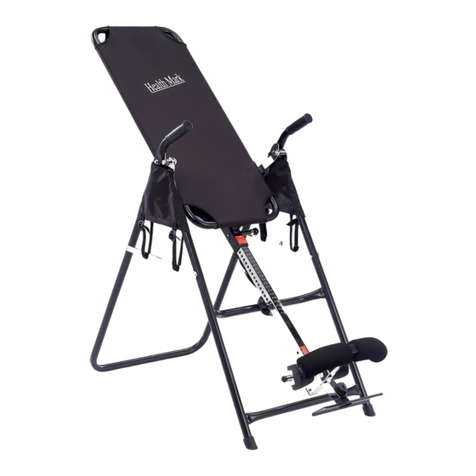
FREQUENTLY ASKED QUESTIONS
How long should I invert?
One of the most important skills for everyone to learn, especially when dealing with
fitness regimens, is to learn to listen to your body. Many people who are new to inversion
may feel some initial discomfort, and in almost all cases it is due to inverting too quickly,
too far, and for too long. We recommend that novices invert for only 1 – 2 minutes at
shallow angles for the first week or so, and then slowly increase the length of time and
the angle of inversion. I will generally invert for 10 – 15 minutes, two to three times a
day, and sometimes even longer, at a variety of angles. My sessions are strictly dependent
upon how I feel, and how long I wish to relax. If you feel any discomfort, simply return
to the upright position.
How far do you have to invert to get the benefits of inversion therapy?
Once you break the horizontal plane, the benefits begin. You begin to release the
accumulated stress on your spine: restoring the proper distraction between the facet
joints, replenishing the moisture to your disks, alleviating cervical pressures, and relaxing
your muscles. Of course, the greater the angle of inversion, the more advanced the effects
of the traction will be. Generally speaking; @ 20 – 30 degrees you will experience mild
stretching of your muscles, ligaments and tendons, improved oxygen flow to the brain
due to increased blood circulation, and realignment of your internal organs; @ 60 degrees
(your hands at just about floor level) your back will receive the required amount of
traction it needs to fully decompress; @ 90 degrees (full inversion) your body will hang
free and you can experience full stretching and traction, and you can perform inverted
exercises (this position is not necessary, nor recommended for everyone).
I feel some discomfort and slight pain after returning to the upright position, is this
normal?
Beginning an inversion program is not unlike beginning any other exercise program.
You are stretching and manipulating your body in a way that it is not used to. This is why
it is important to listen to your body and progress slowly. Ensure that you invert slowly,
return slowly, invert to only a comfortable angle, and invert for short periods of time until
you become experienced.
REMEMBER TO CONSULT YOUR PHYSICIAN PRIOR TO BEGINNING YOUR
INVERSION THERAPY. THERE ARE NUMEROUS INDEPENDENT STUDIES
SURROUNDING INVERSION THERAPY AND ITS BENEFITS. AS WELL, THERE
ARE NUMEROUS QUESTIONS THAT CAN BE ASKED CONCERNING
TECHNIQUE AND PRECAUTIONS. IF YOU HAVE ANY CONCERNS, PLEASE
CONTACT US VIA THE CONTACT INFO ON THE BACK PAGE, OR CALL THE
TOLL FREE NUMBER LISTED IN THE BEGINNING OF THIS MANUAL.





































